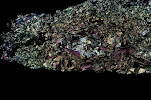This month’s Accretionary Wedge is on the topic of “connections”, which is a terribly appropriate topic for geologists, since everything is interconnected in this universe, and we (generally) study that portion of the universe which we call “Earth”. The planet itself is a ball made of up a variety of layers some of which, over time, do a bit of mixing up. They call this mixing “plate tectonics”, which theory has been around in a changing, but reasonable stable form since I was a child, and existed in a much earlier form (as early as 1915) called “continental drift”. The theory of plate tectonics is a very inter-connecting, unifying theory which helps explain the current distribution of continents around the planet, which parts of the continents (and the ocean floor as well) are wrinkled into mountains (and how the relative motion between two “plates” causes that wrinkling, either in the form of very high mountains when two plates “crash” into one another (e.g. the Himalayas, where India is colliding with Asia) or in gentler mountains where they are sliding past one another (e.g. the San Andres Fault).
Plate tectonics is also useful when looking at rocks, like those I’ve been studying for my PhD project (see photo in my user pic!), which, while at the surface of the earth today, have evidence that they were once buried quite deeply. Every mineral has its “favourite” temperature and pressure—the conditions wherein it will grow, given enough time to do so. Many minerals have a range of compositions, and they will vary their composition based on the temperature and pressure under which they are growing. Garnets will swap in magnesium (Mg) and out iron (Fe) at the same conditions that biotite swaps in iron and swaps out magnesium. This exchange has been studied extensively, going back to the 1970’s with experiments involving putting a tiny amounts of biotite in with large amounts of garnet (and vice versa) with known amounts of Fe and Mg into tiny containers which they then squished (that’s a technical term) with lots of (a known quantity of) pressure and high heat for an extended period of time. Then they checked the mineral which was present in smaller quantity to see how its quantities of Fe and Mg had changed. Doing this a number of times at different conditions permitted them to work out how much iron and magnesium each mineral prefers at a variety of pressure-temperature combinations. As a result of such experiments and comparing them with the proportions of Mg and Fe in biotite and garnet in real rocks, we now have a method of working out just how hot and how squished (how much pressure) rocks must have been to grow the minerals they currently have. This helps us work out the details of the past configurations of the continents—it is known how deeply something must be buried to reach a given pressure, so from the composition of the minerals we can figure out how deep the rock used to be, and therefore what its prior plate tectonic setting would have been. It is all interconnected, from the microscopic level to the scale of an entire continent!
Bandweaving Workshop in February!
3 days ago




No comments:
Post a Comment